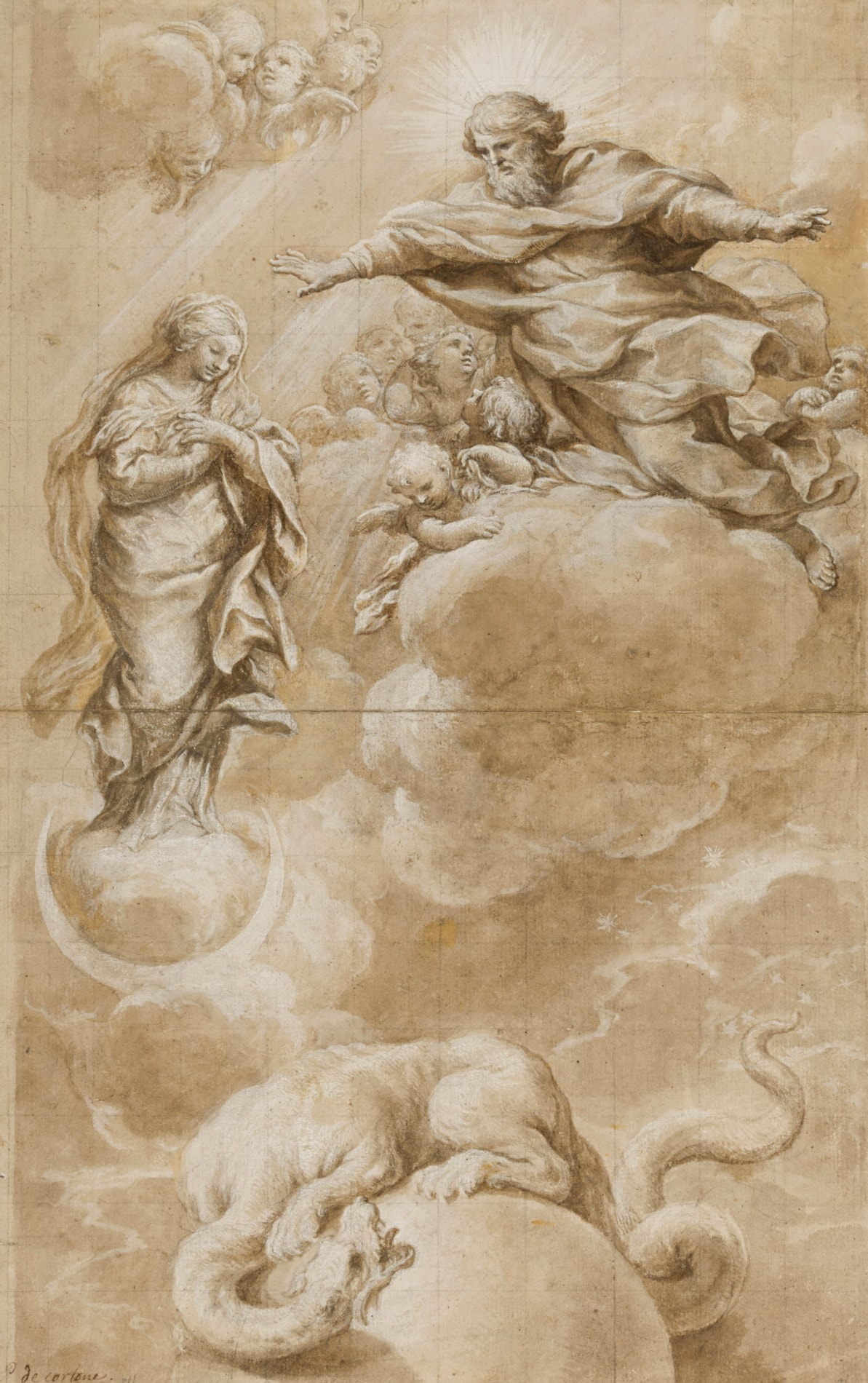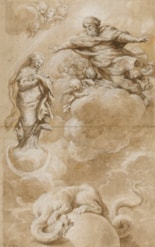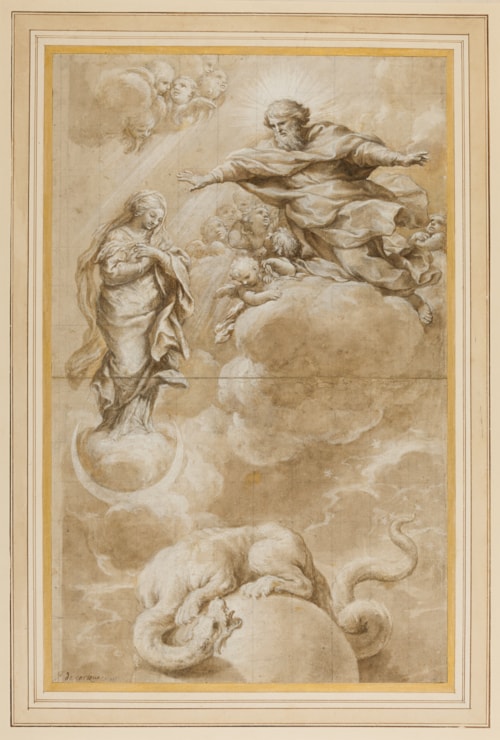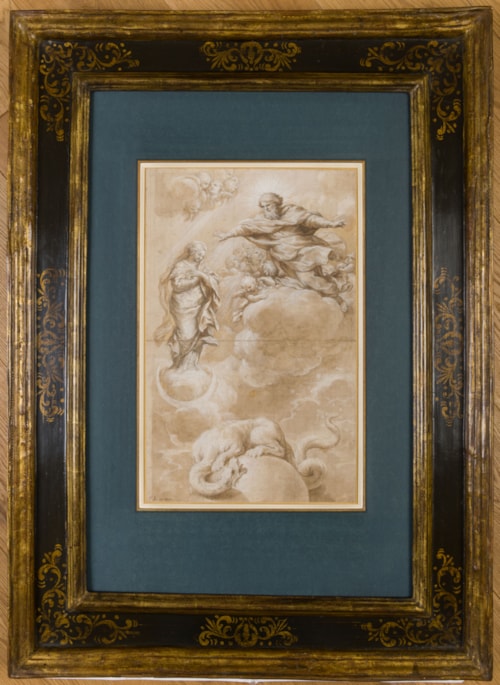Ciro FERRI
(Rome c.1634 - Rome 1689)
The Virgin Immaculate Blessed by God the Father
Pen and brush and brown ink and brown wash, extensively heightened with white and squared for transfer in black chalk, on two joined sheets of buff paper.
Laid down on a 19th century English mount.
Inscribed P. de cortone. at the lower left.
497 x 311 mm. (19 1/2 x 12 1/4 in.)
Laid down on a 19th century English mount.
Inscribed P. de cortone. at the lower left.
497 x 311 mm. (19 1/2 x 12 1/4 in.)
During the last decade and a half of Pietro da Cortona’s career, when he was suffering from poor health but still continuing to receive many important commissions, he began to rely more on his assistants and pupils. As one scholar has noted of Cortona’s works of this period, ‘the master conceived the composition and made the abbozzi, while part of the overpainting (in some cases, all of it) was entrusted to his pupil-collaborators who had proved their ability to assimilate his pictorial language…this was a fluid entrepreneurial arrangement between master and assistants.’ As the assistant most able to replicate his master’s style as a painter, Ciro Ferri was often at the forefront of these collaborative late works.
This large drawing by Ciro Ferri, as Jörg Martin Merz was the first to point out, is a preparatory study for a large altarpiece of The Virgin Immaculate, commissioned in 1657 from Pietro da Cortona by Cardinal Luigi Capponi for the high altar of the church of San Filippo Neri (also known as the Chiesa Nuova) in Perugia; a church dedicated to the Immaculate Conception. The circumstances of the commission made clear that the design of the altarpiece and the painting of its most important parts were entrusted to Cortona, while the remainder of the work was to have been painted by his assistants – with Ferri mentioned in particular – working under the master’s supervision. Cortona indeed enlisted the assistance of Ferri in preparing for the project, and in March 1658 the Cardinal was shown, and approved, a finished drawing for the altarpiece, which may well have been the present sheet by Ferri. However, the painting remained unfinished at the time of Cardinal Capponi’s death in April 1659. Almost two years later, in February 1661, the cardinal’s nephew and heir, the Marchese Scipione Capponi, wrote to request that either Cortona or Ferri finish the altarpiece, which was eventually completed by the former later that year and installed in the church in July 1661.
The present sheet differs from the finished altarpiece in several details, such as the position of the dragon (who is wingless in the drawing) at the bottom, as well as the number and positioning of the putti surrounding God the Father and the distance between the upper and lower sections of the composition. The placement of the Virgin towards the top of the composition of both the drawing and the painting was apparently determined by the fact that the altarpiece was to hang above a tabernacle resting on the altar below, and it was therefore deemed essential that the figure of the Virgin not be blocked from view. The entire lower part of the composition is dominated by the dragon, who sits astride the Earth from which evil will be banished by the result of the Virgin’s immaculate conception.
The Perugia altarpiece was later engraved by François Spierre (1639-1681), a printmaker from Lorraine who settled in Rome in 1659 and became one of the leading engravers in the city, working closely with artists such as Cortona, Ferri and Gian Lorenzo Bernini to reproduce their works. Spierre’s large engraving, which is in reverse to the painted composition, was included in the lavish edition of the Missale Romanum of Pope Alexander VII Chigi, containing texts for the celebration of Catholic Holy Mass, which was published by the Stamperia Camerale in 1662. The present sheet may be likened in stylistic terms to other finished drawings by Ciro Ferri used for the Missale Romanum of Alexander VII, such as a Last Supper and a Circumcision, both in the Metropolitan Museum of Art in New York.
The first recorded owner of this drawing was the English peer John Rushout, 2nd Baron Northwick (1770-1859), who lived in Italy between 1793 and 1800 and developed a particular interest in Italian art. He assembled a fine collection of Old Master and British paintings, as well as manuscript illuminations, miniatures, works of art, antiques, coins and gems. In 1832 he built a gallery for his painting collection at his family seat, Northwick Park in Worcestershire (now Gloucestershire). By 1851 his collection of paintings numbered over 1,400 works, much of which was displayed at Thirlestaine House in Cheltenham, which was opened to the public. Northwick died intestate in 1859, and his collection and the contents of both houses were sold at auction over a period of twenty-one days. Many of the works were bought at the sale by Northwick’s nephew, George Rushout (1811-1877), who had succeeded to the baronetcy, and were returned to Northwick Park. The Northwick collection eventually passed by family descent to another noted collector, Captain Edward George Spencer-Churchill (1876-1964), who sold a number of the Old Master drawings, including the present sheet, at auction in 1920.
This large drawing by Ciro Ferri, as Jörg Martin Merz was the first to point out, is a preparatory study for a large altarpiece of The Virgin Immaculate, commissioned in 1657 from Pietro da Cortona by Cardinal Luigi Capponi for the high altar of the church of San Filippo Neri (also known as the Chiesa Nuova) in Perugia; a church dedicated to the Immaculate Conception. The circumstances of the commission made clear that the design of the altarpiece and the painting of its most important parts were entrusted to Cortona, while the remainder of the work was to have been painted by his assistants – with Ferri mentioned in particular – working under the master’s supervision. Cortona indeed enlisted the assistance of Ferri in preparing for the project, and in March 1658 the Cardinal was shown, and approved, a finished drawing for the altarpiece, which may well have been the present sheet by Ferri. However, the painting remained unfinished at the time of Cardinal Capponi’s death in April 1659. Almost two years later, in February 1661, the cardinal’s nephew and heir, the Marchese Scipione Capponi, wrote to request that either Cortona or Ferri finish the altarpiece, which was eventually completed by the former later that year and installed in the church in July 1661.
The present sheet differs from the finished altarpiece in several details, such as the position of the dragon (who is wingless in the drawing) at the bottom, as well as the number and positioning of the putti surrounding God the Father and the distance between the upper and lower sections of the composition. The placement of the Virgin towards the top of the composition of both the drawing and the painting was apparently determined by the fact that the altarpiece was to hang above a tabernacle resting on the altar below, and it was therefore deemed essential that the figure of the Virgin not be blocked from view. The entire lower part of the composition is dominated by the dragon, who sits astride the Earth from which evil will be banished by the result of the Virgin’s immaculate conception.
The Perugia altarpiece was later engraved by François Spierre (1639-1681), a printmaker from Lorraine who settled in Rome in 1659 and became one of the leading engravers in the city, working closely with artists such as Cortona, Ferri and Gian Lorenzo Bernini to reproduce their works. Spierre’s large engraving, which is in reverse to the painted composition, was included in the lavish edition of the Missale Romanum of Pope Alexander VII Chigi, containing texts for the celebration of Catholic Holy Mass, which was published by the Stamperia Camerale in 1662. The present sheet may be likened in stylistic terms to other finished drawings by Ciro Ferri used for the Missale Romanum of Alexander VII, such as a Last Supper and a Circumcision, both in the Metropolitan Museum of Art in New York.
The first recorded owner of this drawing was the English peer John Rushout, 2nd Baron Northwick (1770-1859), who lived in Italy between 1793 and 1800 and developed a particular interest in Italian art. He assembled a fine collection of Old Master and British paintings, as well as manuscript illuminations, miniatures, works of art, antiques, coins and gems. In 1832 he built a gallery for his painting collection at his family seat, Northwick Park in Worcestershire (now Gloucestershire). By 1851 his collection of paintings numbered over 1,400 works, much of which was displayed at Thirlestaine House in Cheltenham, which was opened to the public. Northwick died intestate in 1859, and his collection and the contents of both houses were sold at auction over a period of twenty-one days. Many of the works were bought at the sale by Northwick’s nephew, George Rushout (1811-1877), who had succeeded to the baronetcy, and were returned to Northwick Park. The Northwick collection eventually passed by family descent to another noted collector, Captain Edward George Spencer-Churchill (1876-1964), who sold a number of the Old Master drawings, including the present sheet, at auction in 1920.
The chief follower and assistant of Pietro da Cortona (1596-1669), Ciro Ferri entered his studio as an apprentice at the age of about sixteen. At this time Cortona was established as arguably the leading painter in Rome, having returned in 1647 from Florence, where he had decorated several rooms in the Palazzo Pitti. Ferri’s earliest major public commission was for part of the fresco decoration of the Gallery of Alexander VII at the Palazzo Quirinale, completed in 1656 under Cortona’s supervision. The following year he was admitted into the Accademia di San Luca, and painted lunette frescoes in a chapel in the church of San Marco. By this time he had come to fully assimilate Cortona’s style and had developed into one of the master’s most faithful pupils and assistants. As Lione Pascoli noted in his biography of the artist, ‘No other disciple than Ciro imitated so well the manner of his master Cortona: no one came close to his beautiful ideas, his bizarre inventions, more than he. None of them surpassed him in drawing…’ Working alongside Guglielmo Cortese, he decorated the Cesi chapel in the Roman church of Santa Prassede. Between 1659 and 1665 Ferri worked in Florence for the Grand Duke Ferdinando II de’Medici, completing the fresco decoration of the Sala di Apollo – which had been begun by Cortona – and the Sala di Saturno in the Palazzo Pitti, which may be regarded as among his most important works.
After some years spent working in Bergamo and Venice, Ferri returned to Rome for good following the death of his master in 1669. He completed several of Cortona’s unfinished projects, notably for mosaics at Saint Peter’s, while continuing to receive his own independent commissions. The most significant of these was for the fresco decoration of the cupola of the Roman church of Sant’Agnese in Agone, commissioned by the Pamphili family, which was begun in 1670 but was still unfinished at Ferri’s death nearly twenty years later. It was also around 1670 that he began to work occasionally as a sculptor, and to produce drawings for both sculptural and architectural projects. Pascoli wrote that Ferri ‘invento molti disegni per varie fabbriche e per vary altari’, and a number of designs for altars, reliquaries and tabernacles for churches in Rome and Florence, dating from the 1670s onward, are known; these include altars for the churches of Sant’Agnese, San Giovanni dei Fiorentini, San Nicola dei Tolentino and Santa Maria sopra Minerva in Rome, as well as the architecture and decoration of the choir chapel of Santa Maria Maddalena dei Pazzi in Florence, where he worked between 1675 and 1685. Much of Ferri’s later career was also occupied with providing designs for ornamental motifs in bronze or stucco, as well as for tapestries, mirrors, tabernacles, ceremonial carriages and, not least, over a hundred prints.
In his biography of the artist, Pascoli stated that Ferri preferred drawing to painting. His drawings were widely admired in his lifetime, and a number of them were reproduced as engravings. Yet his lifelong adherence to Cortona’s style has meant that drawings by the two have often been confused, and modern scholarship has only recently been able to differentiate between the draughtsmanship of master and pupil. Indeed, most extant drawings by Ferri have originally borne attributions to Cortona, which is true of the present sheet. More than three hundred drawings by Ferri have survived. The largest single collection of drawings by the artist, numbering over 140 sheets, is in the Istituto Centrale per la Grafica in Rome, while smaller groups are in the Museum Kunst Palast in Düsseldorf, the Uffizi in Florence and the Royal Collection at Windsor Castle.
After some years spent working in Bergamo and Venice, Ferri returned to Rome for good following the death of his master in 1669. He completed several of Cortona’s unfinished projects, notably for mosaics at Saint Peter’s, while continuing to receive his own independent commissions. The most significant of these was for the fresco decoration of the cupola of the Roman church of Sant’Agnese in Agone, commissioned by the Pamphili family, which was begun in 1670 but was still unfinished at Ferri’s death nearly twenty years later. It was also around 1670 that he began to work occasionally as a sculptor, and to produce drawings for both sculptural and architectural projects. Pascoli wrote that Ferri ‘invento molti disegni per varie fabbriche e per vary altari’, and a number of designs for altars, reliquaries and tabernacles for churches in Rome and Florence, dating from the 1670s onward, are known; these include altars for the churches of Sant’Agnese, San Giovanni dei Fiorentini, San Nicola dei Tolentino and Santa Maria sopra Minerva in Rome, as well as the architecture and decoration of the choir chapel of Santa Maria Maddalena dei Pazzi in Florence, where he worked between 1675 and 1685. Much of Ferri’s later career was also occupied with providing designs for ornamental motifs in bronze or stucco, as well as for tapestries, mirrors, tabernacles, ceremonial carriages and, not least, over a hundred prints.
In his biography of the artist, Pascoli stated that Ferri preferred drawing to painting. His drawings were widely admired in his lifetime, and a number of them were reproduced as engravings. Yet his lifelong adherence to Cortona’s style has meant that drawings by the two have often been confused, and modern scholarship has only recently been able to differentiate between the draughtsmanship of master and pupil. Indeed, most extant drawings by Ferri have originally borne attributions to Cortona, which is true of the present sheet. More than three hundred drawings by Ferri have survived. The largest single collection of drawings by the artist, numbering over 140 sheets, is in the Istituto Centrale per la Grafica in Rome, while smaller groups are in the Museum Kunst Palast in Düsseldorf, the Uffizi in Florence and the Royal Collection at Windsor Castle.
Provenance
John Rushout, 2nd Baron Northwick, Northwick Park, Blockley, Worcestershire, and Thirlestaine House, Cheltenham, Gloucestershire
By descent to his nephew, George Rushout, 3rd Baron Northwick, Northwick Park
Thence by descent to Captain Edward George Spencer-Churchill, Northwick Park
Northwick sale (‘A Portion of the Famous & Important Collection of Drawings by Old Masters, The Property of the late John, Lord Northwick’), London, Sotheby’s, 1-4 November 1920, lot 54 (as Pietro da Cortona: ‘Study for a picture of the Virgin Immaculate. Sepia wash touched with white. 19 1/2 in. by 12 1/4 in. (50 cm. by 31 cm.)’)
Otto Wessner, St. Gallen, Switzerland
His posthumous sale, Munich, Galerie Hugo Helbing, 8-9 June 1926, lot 746 (as Pietro da Cortona: ‘Maria als Himmelskönigin und Gottvater mit Engeln auf Wolken. Darunter der Teufel als Drache. Sepiazeichnung, weib gehöht. 49,5 x 31,2 cm. Aufgezogen: (Lord Northwick’s Collection)’)
Possibly Simon Meller, Budapest, Munich and Paris
Sale, Luzern, Galerie Fischer, 11 November 1949, lot 2854 (as Pietro da Cortona, bt. Landolt)
Robert Landolt, Chur (Lugt 2223a), his stamp on the reverse of the old mount, with associated numbering No 55 in pencil
Thence by descent.
By descent to his nephew, George Rushout, 3rd Baron Northwick, Northwick Park
Thence by descent to Captain Edward George Spencer-Churchill, Northwick Park
Northwick sale (‘A Portion of the Famous & Important Collection of Drawings by Old Masters, The Property of the late John, Lord Northwick’), London, Sotheby’s, 1-4 November 1920, lot 54 (as Pietro da Cortona: ‘Study for a picture of the Virgin Immaculate. Sepia wash touched with white. 19 1/2 in. by 12 1/4 in. (50 cm. by 31 cm.)’)
Otto Wessner, St. Gallen, Switzerland
His posthumous sale, Munich, Galerie Hugo Helbing, 8-9 June 1926, lot 746 (as Pietro da Cortona: ‘Maria als Himmelskönigin und Gottvater mit Engeln auf Wolken. Darunter der Teufel als Drache. Sepiazeichnung, weib gehöht. 49,5 x 31,2 cm. Aufgezogen: (Lord Northwick’s Collection)’)
Possibly Simon Meller, Budapest, Munich and Paris
Sale, Luzern, Galerie Fischer, 11 November 1949, lot 2854 (as Pietro da Cortona, bt. Landolt)
Robert Landolt, Chur (Lugt 2223a), his stamp on the reverse of the old mount, with associated numbering No 55 in pencil
Thence by descent.
Literature
Nicholas Turner, ‘Disegni di Pietro da Cortona e Ciro Ferri. Roma, Gabinetto Nazionale delle Stampe, 1978’ [book review], Prospettiva, April 1979, p.77; Giuliano Briganti, Pietro da Cortona o della pittura barocca, Florence, 1982 ed., p.295 (as Pietro da Cortona); Jörg Martin Merz, Cortona-Studien, unpublished Ph.D dissertation, Eberhard-Karls Universität, Tübingen, 1985, p.190 (as attributed to Pietro da Cortona); Jörg Martin Merz, Pietro da Cortona und sein Kreis: Die Zeichnungen in Düsseldorf, Berlin, 2005, p.69, p.454, note 250; Michael Matile, ed., Zwiegespräch mit Zeichnungen: Werke des 15. bis 18. Jahrhunderts aus der Sammlung Robert Landolt, exhibition catalogue, Zurich, 2013-2014, pp.44-46, no.14 (entry by Jörg Martin Merz).
Exhibition
Zurich, Graphische Sammlung ETH, Zwiegespräch mit Zeichnungen: Werke des 15. bis 18. Jahrhunderts aus der Sammlung Robert Landolt, 2013-2014, no.14.






